Introduction
In the realm of data analysis, the ability to forge meaningful connections between various datasets is paramount for driving operational efficiency and informed decision-making. Power BI stands out as a powerful tool that facilitates this by enabling users to create and manage relationships between tables. Understanding the intricacies of these relationships—ranging from one-to-one to many-to-many—is essential for building a robust data model that not only enhances reporting accuracy but also streamlines the analytical process.
As organizations grapple with challenges such as data inconsistencies and time-consuming report generation, mastering the art of relationship management within Power BI can unlock a treasure trove of insights. This article delves into the fundamentals of Power BI relationships, offering practical solutions and strategies that empower users to transform raw data into actionable intelligence, ultimately fostering business growth and innovation.
Understanding the Basics of Power BI Relationships
In this tool, understanding power bi relationships explained between various tables is crucial for building an efficient model that enhances operational effectiveness. These connections enable the creation of cohesive datasets that Power BI can analyze with precision, facilitating informed decision-making. Mastering the three main types of relationships—one-to-one, one-to-many, and many-to-many—illustrates the concept of power bi relationships explained, which is crucial for optimizing information modeling.
For example, a one-to-many relationship permits a single record in a primary table to link to several records in a secondary table, a structure frequently observed in transactional information models. This understanding of power bi relationships explained is crucial for achieving precise reporting and perceptive analysis.
Our BI services include a 3-Day Sprint aimed at accelerating the development of expertly designed reports, ensuring effective reporting and information consistency. One of the standout features is the General Management App, which offers comprehensive management and smart reviews to enhance your workflow.
Moreover, a recent case study underscores the introduction of the 100% Stacked Area Chart in Business Intelligence, which significantly aids users in visualizing the relative percentage of multiple information series over time. This visual not only enhances interpretation but also illuminates how relationships between different points evolve, providing deeper insights into operational trends.
As emphasized by Microsoft, certification ensures that visuals, including the new chart, do not interact with external services, thereby guaranteeing that your PDF files are securely stored and encrypted within the report, in accordance with your report sensitivity settings. This aspect reinforces the significance of secure information management in Business Intelligence.
Additionally, utilizing effective information modeling, as demonstrated by user MaineGuy1993, highlights that having SQL open on the server while using BI on a laptop can significantly enhance operational efficiency. By adopting these concepts and using our BI services alongside RPA solutions such as EMMA RPA and Automate, you can convert unrefined information into actionable insights. These RPA tools enhance BI by automating repetitive tasks, thus overcoming challenges like time-consuming report creation and data inconsistencies, ultimately driving business growth.
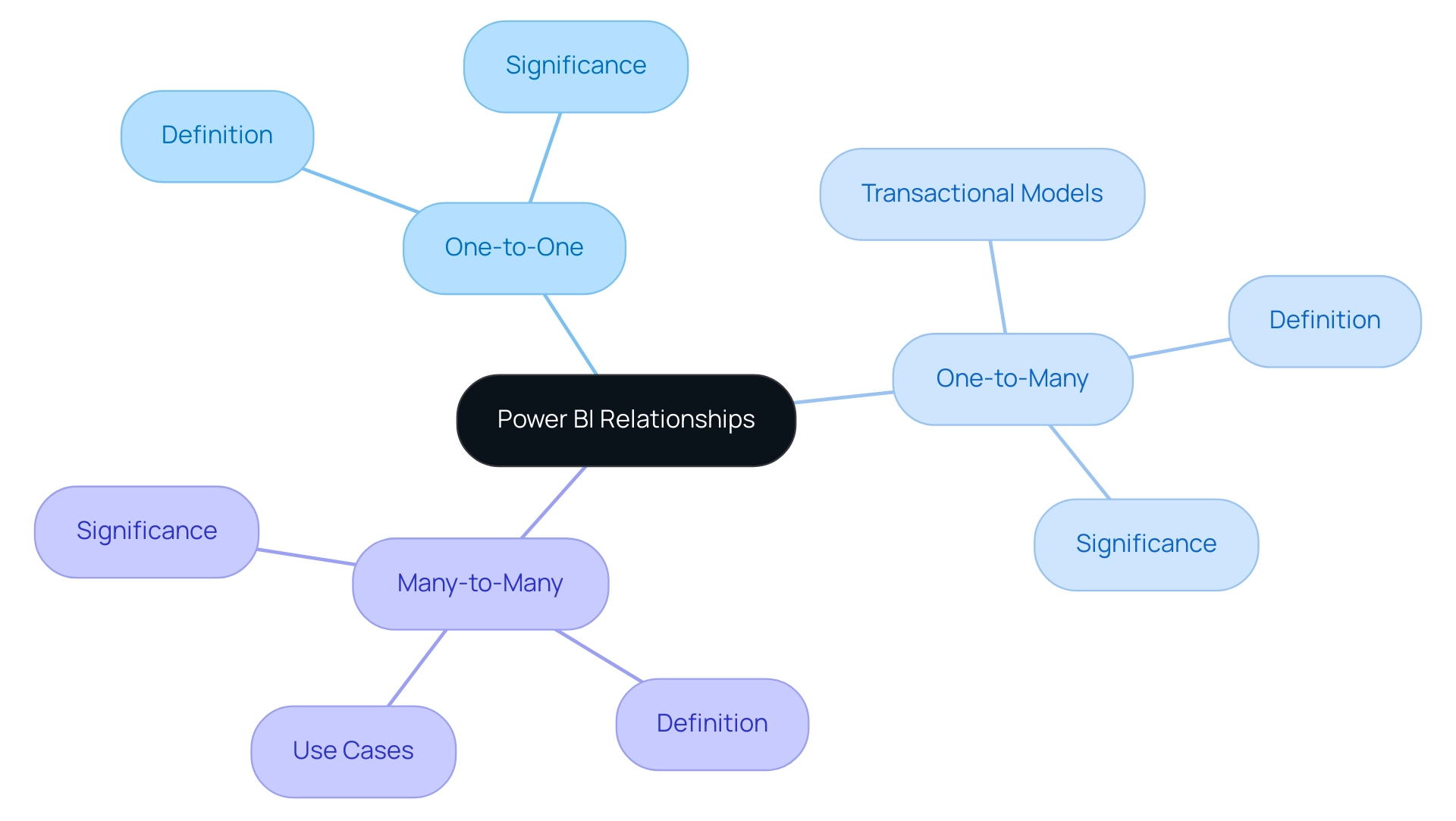
Creating and Managing Relationships in Power BI
The process of establishing connections in Power BI relationships explained starts in the ‘Model’ view, yet many users find themselves caught in a cycle of time-consuming report creation. This interface allows you to visually create connections between datasets, which is an example of power bi relationships explained, by simply dragging and dropping fields. Alternatively, you can access the ‘Manage Connections’ option in the Home tab to manually define new associations, specify the involved tables, and set the appropriate cardinality, as power bi relationships explained suggests.
However, without a robust governance strategy, inconsistencies can arise, leading to confusion and a lack of trust in your insights. To tackle these challenges, regular review and management of these connections is crucial for maintaining accuracy and efficiency. Power BI’s autodetect feature assists in the process of power bi relationships explained by recognizing potential connections based on matching column names and types, though manual adjustments may still be necessary to ensure optimal performance.
As industry expert Ricardo notes, ‘I confirmed the values in the matrix were correct by comparing them to the measures I had previously created for each attribute (entrega, forecast, venda).’ This emphasizes the need for actionable guidance — without clear direction, stakeholders may be left with information that lacks context. For additional support, the case study titled ‘Guidance for Relating Higher Grain Facts‘ offers essential insights on managing connections effectively in scenarios with higher granularity.
By utilizing Business Intelligence and RPA solutions, along with a strong governance strategy, you can improve operational efficiency and convert raw information into actionable insights, ultimately fostering growth and innovation.
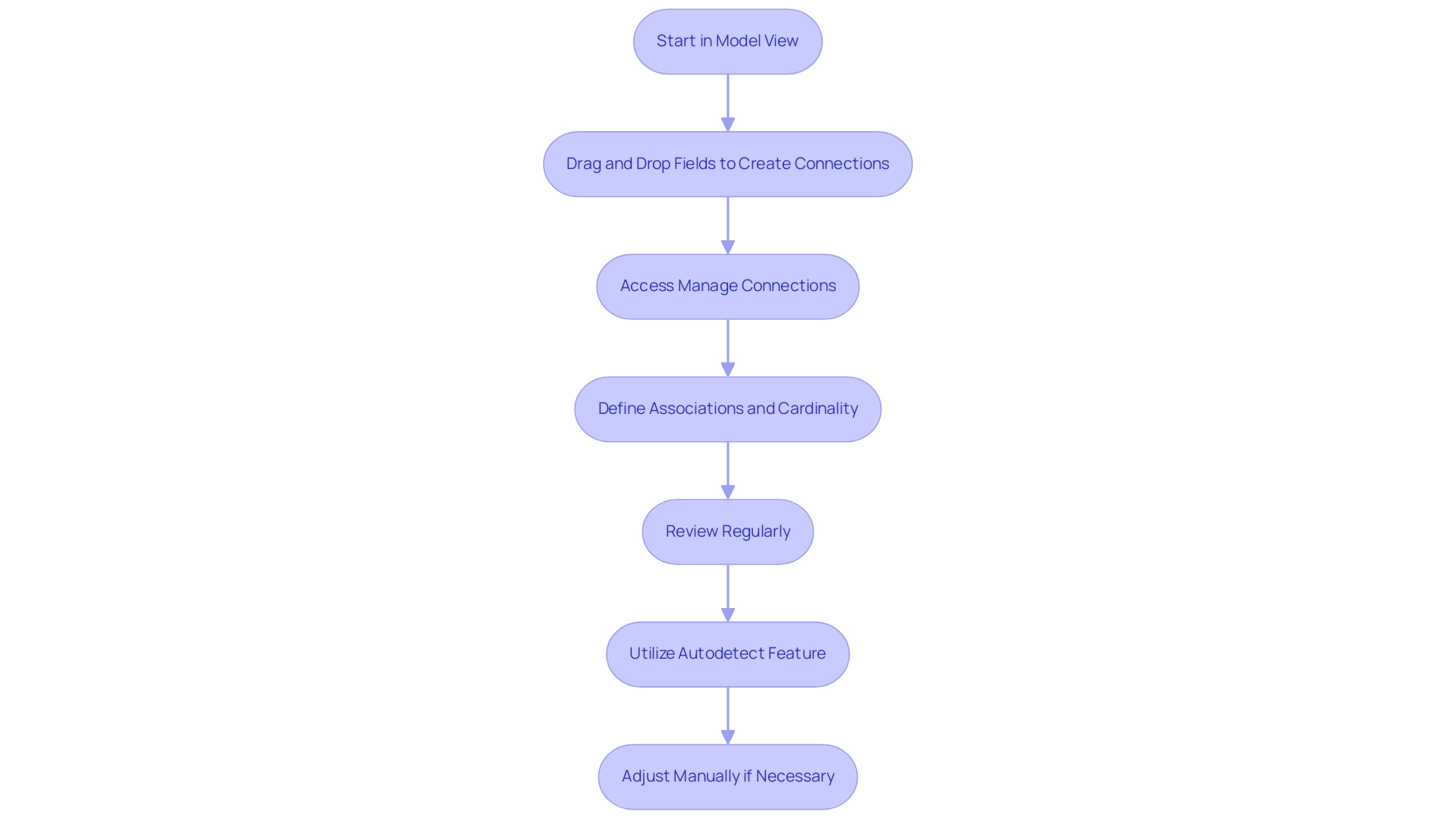
Exploring Types of Relationships: Cardinality and Direction
In Power BI, the concept of power bi relationships explained emphasizes that cardinality is essential as it determines the nature of connections between tables, influencing how information interacts within your models. Grasping these connections, as power bi relationships explained, is vital for utilizing Business Intelligence and Robotic Process Automation (RPA) to foster data-driven insights and operational efficiency necessary for business growth. Common challenges include time-consuming report creation, data inconsistencies, and a lack of actionable guidance, which can hinder effective decision-making.
The most common types of relationships are:
- One-to-One (1:1): In this scenario, each row in one dataset is associated with one, and only one, row in the second dataset. This relationship is straightforward and ensures information integrity.
- One-to-Many: Here, a record in one dataset can relate to multiple records in another. A classic example illustrating power bi relationships explained is the connection between a customer and their orders, where one customer can place multiple orders, showcasing the need for effective information management and reporting.
- Many-to-Many: This type complicates data models as entries in both datasets can relate to multiple entries in each other, creating a more intricate web of connections that can hinder timely insights if not managed properly.
Furthermore, understanding how power bi relationships explained affects the orientation of these connections is essential, especially in how filters are utilized across datasets. By default, Power BI creates single-directional connections, meaning that filters applied to one dataset will influence associated datasets, but not vice versa. As noted by Priyanka P Amte, “Both direction filtering, filters can flow in both directions between datasets.”
This emphasizes the complexity of managing data connections and the significance of understanding power bi relationships explained for deriving insights.
A practical approach for managing connections is to utilize a single bridging structure, which can simplify intricate associations and improve reporting efficiency. Furthermore, in a case study titled ‘Autodetection of Connections,’ a user successfully removed all other columns from the table, allowing the link to other tables to be auto detected as one-to-many, effectively fixing the issue. Grasping these dynamics, as highlighted in power bi relationships explained, is crucial for developing effective reports and dashboards, allowing you to manipulate and examine your information with confidence, ultimately overcoming challenges such as time-consuming report creation and inconsistencies.
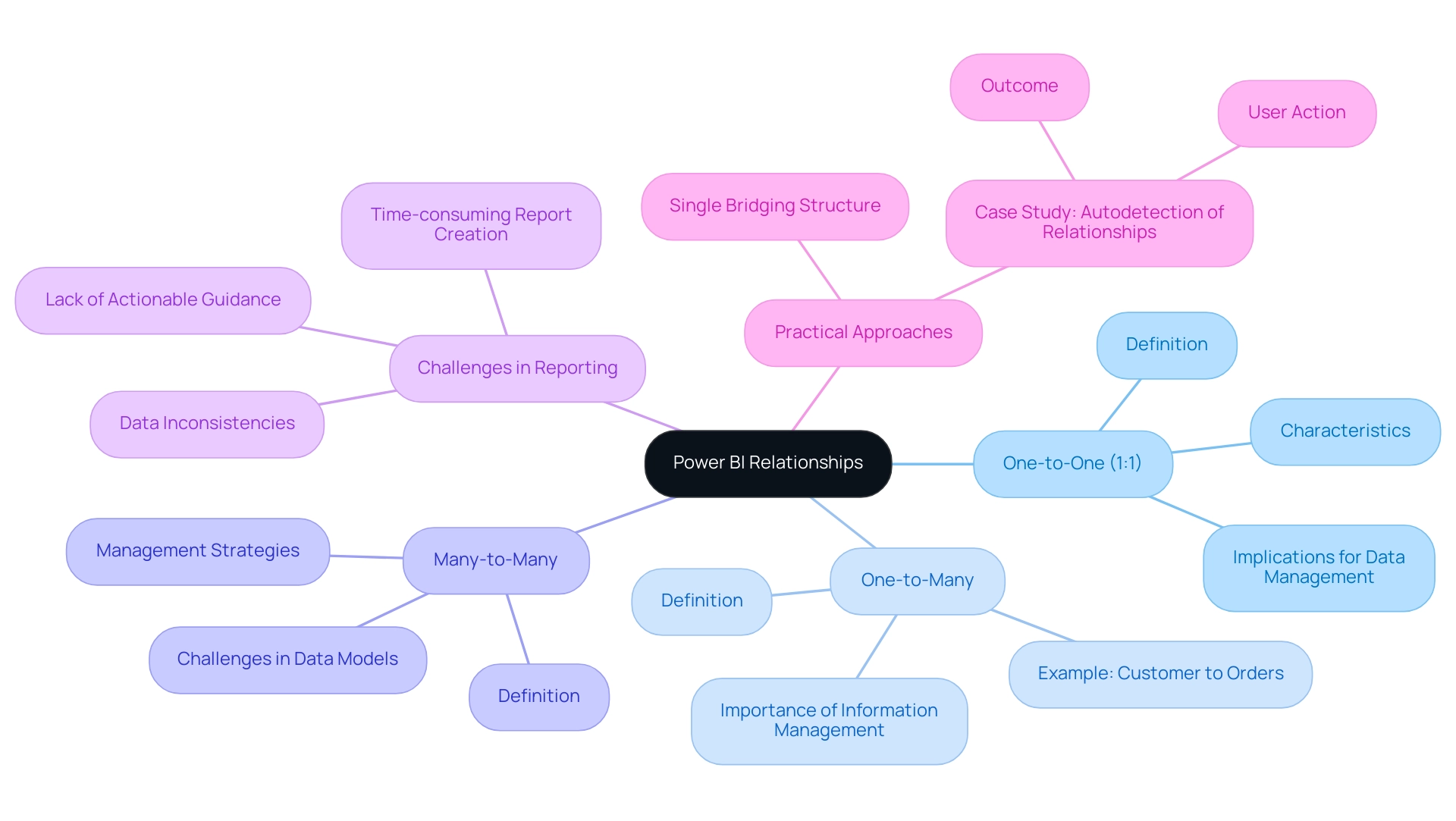
Troubleshooting and Optimizing Power BI Relationships
BI users frequently face typical connection problems, such as unclear associations, circular dependencies, and incorrect cardinality configurations, which can greatly obstruct analysis. To troubleshoot these issues effectively, begin by carefully examining your model configuration for any errors identified by BI, as these frequently indicate broken connections. It’s crucial to verify that all connections are accurately formed and that the cardinality corresponds with the foundational structure, as illustrated by the Employee Role table that presents 8 distinct employees with different roles, highlighting how connections can differ in complexity.
Utilizing RPA, especially tools such as EMMA RPA and Power Automate, can automate repetitive tasks linked to information management, enhancing operational efficiency and offering a competitive edge through improved insights. To optimize your model, consider minimizing the number of connections where feasible or employing calculated columns to streamline complex models. Furthermore, altering connections and introducing constraints to visuals can further improve your information model.
Frequently reviewing and enhancing your model is not only a best practice; it can greatly improve performance and result in more precise insights. As pointed out by a frequent community visitor, maintaining clarity in power bi relationships explained is crucial for effective decision-making, especially in data-rich environments. Additionally, resolving typical data connection problems, as outlined in the case study ‘Troubleshooting Techniques for Data Connection Issues,’ is essential for accessing current information in BI reports.
Proactively addressing these challenges will enable you to utilize BI’s full potential, driving data-driven insights and promoting business growth.
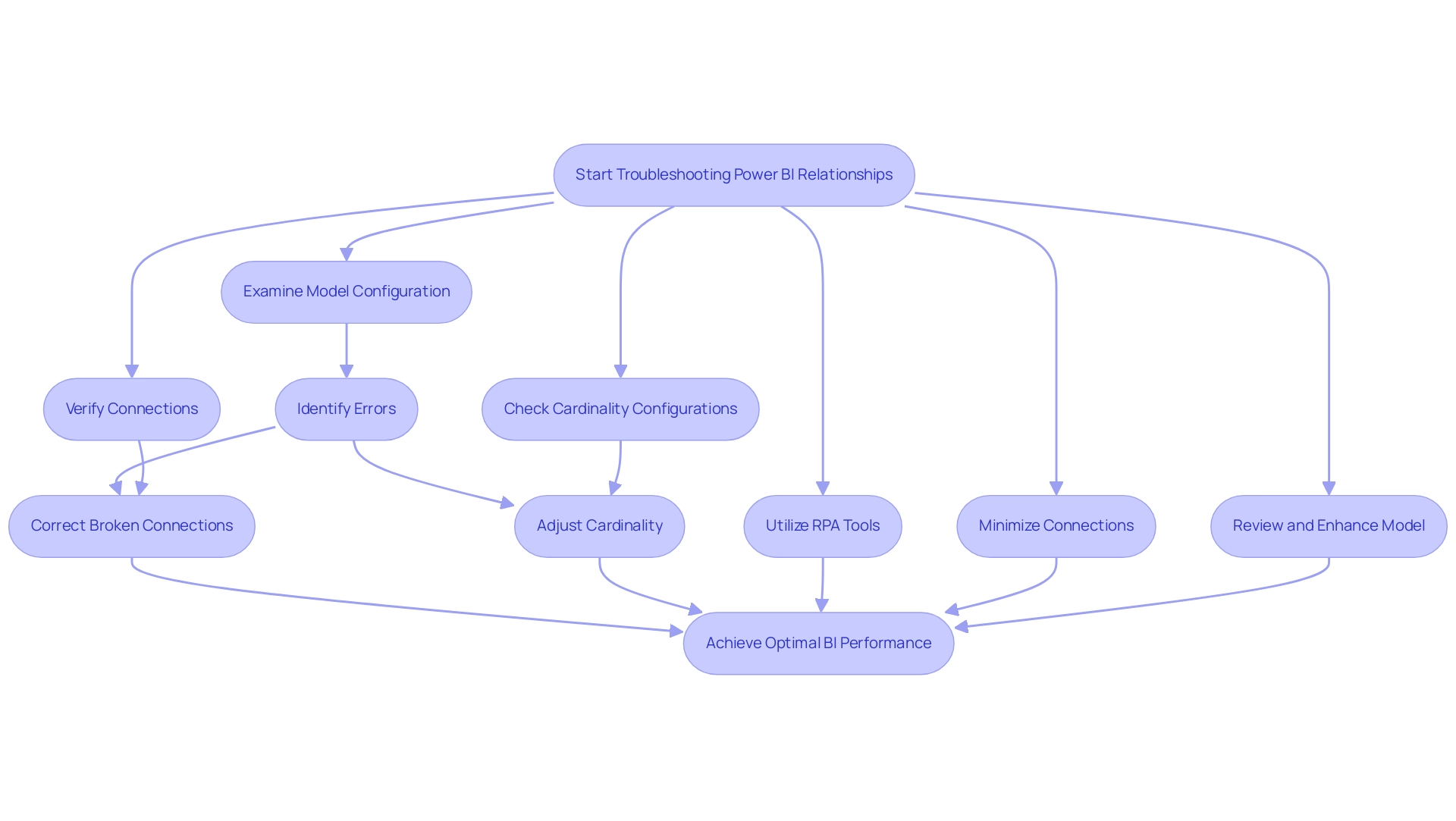
Advanced Relationship Management: DAX and Virtual Relationships
Mastering advanced relationship management in business intelligence, as outlined in Power BI relationships explained, is pivotal for enhancing analytical capabilities and driving operational efficiency. By utilizing DAX (Data Analysis Expressions), you can create calculated columns and measures that reference multiple tables, offering a robust framework for analysis. Our Power BI services, especially the 3-Day Sprint for quick report creation and the General Management App for thorough management, enable you to tackle common challenges such as time-consuming report generation and inconsistencies, ensuring efficient reporting and actionable insights.
One of the most powerful features available to you is the use of virtual connections. These temporary connections allow you to conduct analyses without altering the underlying data model, offering remarkable flexibility. For instance, the MAXX function can be utilized to determine the maximum total amount across all orders, showcasing the depth of insights that can be derived.
Furthermore, BI’s operation in separate national and regional clouds ensures compliance with local regulations, which is crucial for organizations. Real-world case studies, such as ‘Usage Metrics in National/Regional Clouds,’ illustrate how organizations have successfully employed advanced DAX techniques to maintain high standards of security and privacy while supporting local service delivery needs. For example, one organization reported a 30% reduction in report generation time after implementing our 3-Day Sprint service.
This method not only emphasizes the practical advantages of using virtual relationships in BI but also provides an explanation of Power BI relationships explained in real-world applications. By familiarizing yourself with these advanced techniques and utilizing our Power BI solutions, you can unlock new dimensions of insight, ensuring that your data analysis is both efficient and impactful.
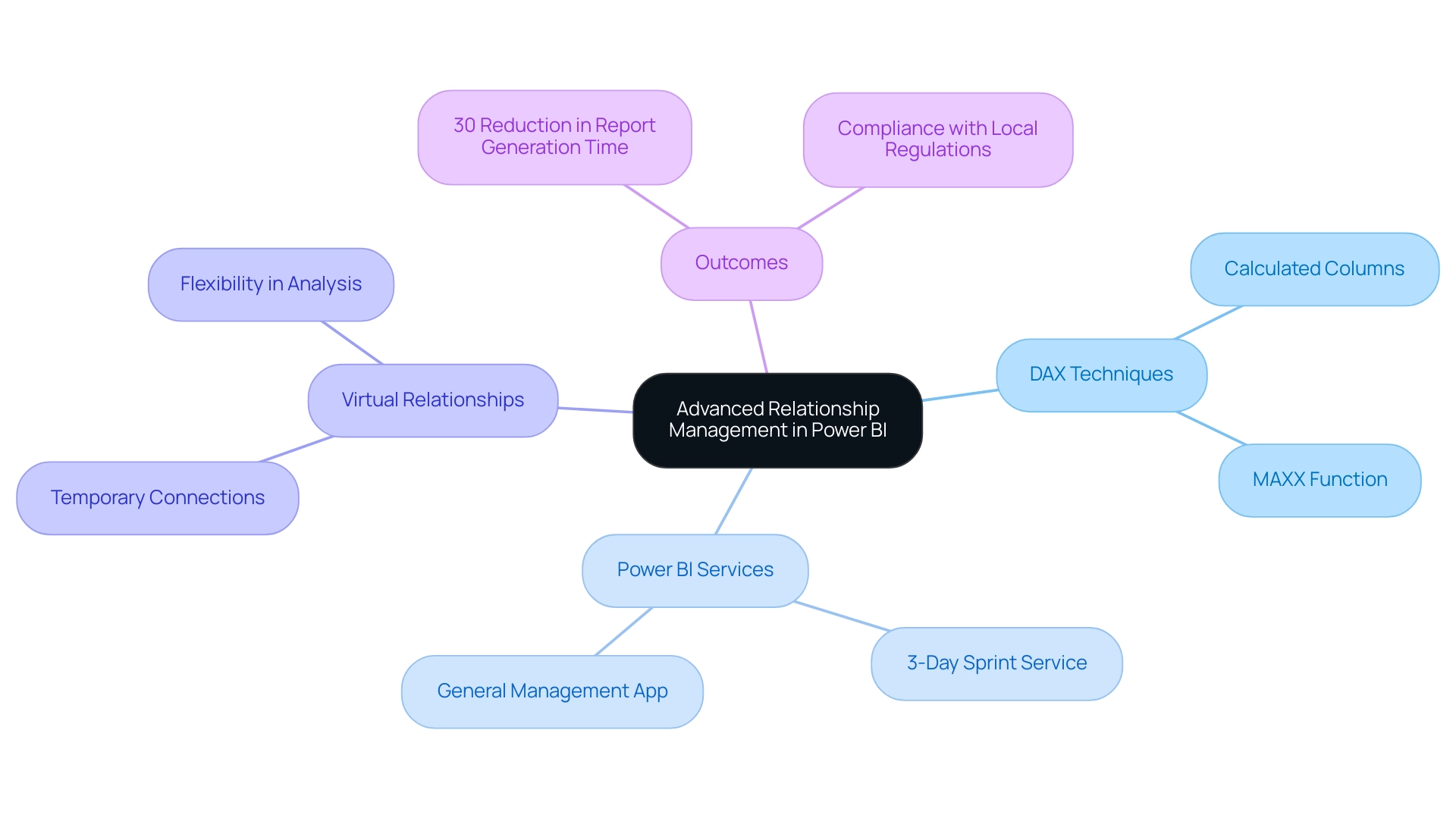
Conclusion
Understanding the intricacies of Power BI relationships is fundamental for any organization striving to harness the full potential of its data. From the foundational concepts of:
- one-to-one
- one-to-many
- many-to-many relationships
to the advanced management techniques utilizing DAX and virtual relationships, each aspect plays a crucial role in constructing an effective data model. This comprehensive approach not only enhances reporting accuracy but also streamlines the analytical process, ultimately leading to better-informed decision-making.
By implementing robust governance strategies and leveraging tools like RPA, organizations can address common challenges such as:
- data inconsistencies
- time-consuming report generation
Regularly reviewing and optimizing relationships within Power BI ensures that insights drawn from data remain relevant and actionable. The incorporation of features like autodetection of relationships and calculated columns further empowers users to create dynamic and efficient models that adapt to changing business needs.
As organizations continue to navigate the complexities of data analysis, mastering relationship management in Power BI stands as a key differentiator. By embracing these strategies and solutions, businesses can transform raw data into actionable insights, fostering innovation and driving growth. The time to invest in understanding and optimizing Power BI relationships is now, as the benefits extend far beyond immediate operational efficiencies, paving the way for a data-driven future.

